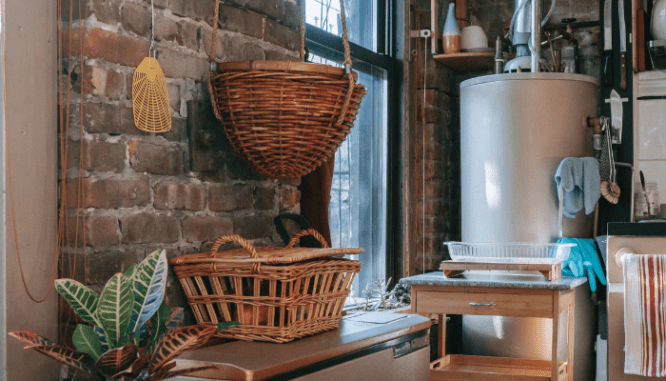What’s Not Covered in a Home Inspection? 8 Items Home Inspectors Pass Over
- Published on
- 5 min read
-
 Kristine Hansen Contributing AuthorClose
Kristine Hansen Contributing AuthorClose Kristine Hansen Contributing Author
Kristine Hansen Contributing AuthorKristine Hansen resides in a 1920s Milwaukee bungalow and contributes stories about the real-estate market to outlets that include Realtor.com and HomeLight.com and also covers art, design and architecture for ArchitecturalDigest.com, Invaluable.com and Milwaukee Magazine.
If you’re like most sellers, you hope to pass the home inspection’s 1,600-feature check with flying colors so you can sail through closing. While it’s a smart move to complete necessary repairs beforehand, don’t go overboard and waste your time (and money) on items not covered in the report.
Your home inspector won’t test every lightbulb, break open the walls to examine electrical, or dig into your underground septic system. Home inspectors are overall evaluators — not licensed electricians, plumbers, or HVAC technicians. Their primary role is to search for structural issues, mechanical defects, and health and safety concerns.
“Home inspectors wear a lot of hats, but they’re not necessarily an expert in every area,” says top agent Jason Mickelson of Ames, IA, who works with over 69% more single-family homes than the average agent.
Not to mention, the average home inspection takes between two and two and a half hours (an hour to an hour and a half for condos), which is hardly enough time to drive a shovel into the ground to take a peek at your septic system.
To uncover what’s not covered in a home inspection, we checked in with Mickelson and Kathleen Kuhn, HouseMaster President and CEO and a licensed home inspector. HouseMaster is the oldest and one of the largest home inspection companies in North America, with 320 franchises across the U.S. and in Canada. Here are eight items not included in a standard home inspection:

1. The sewer line
Most inspectors will not look at the sewer line in a standard home inspection, which connects your home to the city line. However, Kuhn shares that an increasing number of buyers are requesting an additional inspection service from a plumbing and drain company to check the sewer for cracks, tree roots, clogs, or any collapsed lines. Using a video camera, a specialist will scope the line and detect any repairs that may be needed. Because these repairs are often expensive, says Kuhn, “you may want to consider having these inspections before a buyer comes along as these issues will require immediate repair.”
2. Paint, wallpaper, and other finishes
According to the American Society of Home Inspectors (ASHI), inspectors are not required to inspect “paint, wallpaper, or other finish treatments.”
“Those are purely cosmetic and not something the inspector will — or should — point out,” adds Mickelson, who recently worked with a seller who asked if he should paint his interior before the home inspection.
That said, “when an inspector identifies peeling paint, they are generally going to assess the potential cause if any,” says Kuhn. Three common causes for peeling or cracking paint are:
- Water/humidity
- Improper paint application or prep-work
- Expired or low-quality paint
Your home inspector only sees the first listed cause as a “red flag” since this may indicate that the home has a history of water damage.
Home inspectors will not test for lead-based paint which is common in homes built before 1978. If a buyer is concerned about lead-based paint, they need to hire a certified inspector or a risk assessor to evaluate the paint and recommend either abatement or continued good maintenance.
3. Mold and pests
Generally, a home inspection excludes identifying “the presence of plants, animals, and other life forms and substances that may be hazardous or harmful to humans including, but not limited to, wood-destroying organisms, molds, and mold-like substances.”
If a home inspector finds mold, they may label it on the report as “potentially mold,” says Mickelson. But they won’t break out mold testing kits to confirm. It’s up to the buyer to hire a certified mold inspector to evaluate further.
If a home inspector does report mold, order a mold test to disprove or verify the finding before negotiating removal costs with the buyer.
“I’ve been in some attics where there are mold spores, but they’re inactive. That’s a no-no — an inspector should not flag a home as unsafe without doing further tests,” Mickelson shares.

4. Home decor and finishes
Messy clutter or leaving the holiday decorations up too long won’t cause you to fail the home inspection report. However, you should keep your interior relatively clean, so the home inspector can easily access all areas of your home. The National Association of Home Inspectors even shares that a home inspector must reach these readily accessible areas to complete the report. It’s also going to extend the amount of time this inspector is in your home if they have to push aside boxes or other items to, say, view an electrical panel.
As for the subway tiles you installed in the bath or kitchen, the inspector will notice them — but not for the reason you think. “Inspectors will check all tiles looking for loose tiles or any indication that there may be moisture issues behind the tile,” says Kuhn. “A crack does not necessarily indicate a more serious condition.”
5. Inside of the fireplace and chimney
Don’t expect the home inspector to get down on their hands and knees to gaze up the flue. According to the American Society of Home Inspectors, the home inspection report covers the inspection of chimneys and vent systems, fuel-burning accessories installed into a fireplace, and a home’s fuel-burning fireplaces, stoves, and fireplace inserts. It does not cover:
- Vent systems
- Flues, seals, and gaskets
- Fire screens and doors
- Mantels and fireplace surrounds
- Combustion air components
- Heat distribution assets
- Automatic fuel feed devices
- Anything located outside of the inspected structure
Still, Mickelson advises homeowners to have their fireplace cleaned and checked before the home inspection. The average cost to inspect and clean a chimney runs $80 to $500, depending on what’s needed.
“A recent trend in home inspection is buyers adding additional inspection services to the evaluation of the home such as level-2 chimney inspection,” Kuhn says. A chimney sweep — ideally one certified by Chimney Safety Institute of America — uses a camera to view the chimney interior to identify significant cracks or other damages.
6. Internal electrical components
Again, the home inspector’s job is to conduct a visual inspection, not to tinker around with your home’s inner workings. For instance, the inspector won’t open a wall to view the electrical work, a complicated job that’s outside the scope of their 1,600-item report. But they will, according to the American Society of Home Inspectors, examine these nine items:
- Service drop
- Service entrance conductors, cables, and raceways
- Service equipment and main disconnects
- Service grounding
- Interior components of subpanels and service panels
- Conductors
- Overcurrent protection devices
- Lighting fixtures, switches, and receptacles
- Ground fault circuit interrupters
“Today’s electric needs have grown exponentially,” says Kuhn. “It’s not uncommon to see doubled-up circuits or other DIY electrical work that becomes a safety hazard. Reverse polarity at electrical outlets is also very common. Reverse polarity is easy to fix but rarely noticed by a homeowner until they get a shock.”
On a final note: Don’t skip out on replacing burnt-out lightbulbs in any overhead fixtures or tableside lamps. These lights help the inspector clearly see the evaluated items. And, ultimately, the inspector wants to know that the electrical system or appliance that bulb is linked to is in working order. Some inspectors may mark the electricity as faulty if there’s not a working bulb to test it.

7. Building code violations
Remember, the home inspector is not a building inspector. They are not required to determine compliance with codes or regulations. So don’t sweat it if you’re selling a historic home that, if it were to be renovated tomorrow, would need to be updated first with items like proper insulation or adequate removal area from a window (in case of a fire rescue).
8. The underground septic system
Often the only way to know you have a defective underground septic system is when it overflows in your basement or the yard or when you hear gurgling in the sink.
“Water penetration and plumbing issues are very common,” says Kuhn. “Unfortunately, many homeowners don’t commit to regular home maintenance either due to a lack of knowledge or time. As a result, small things can become big issues.”
A home inspector will run the faucets and flush the toilets, listening for normal sounds, but they won’t examine the underground system. To further investigate the septic tank, a specialist would need to insert a small camera into the system. The home inspector will only note the following details:
- When the tank was last pumped
- That the tank it’s far from wells or streams
- The sludge level is less than one-third of the tank’s volume
- The tank is the appropriate size for the house (for example, a four-bedroom house requires a 1,200-gallon tank).

Focus on the primary home inspection items
Now that you know what a home inspection doesn’t cover, you can better prepare for the visit. Spend your energy checking and repairing your home’s key structural features.
“As a rule of thumb, big-ticket items like a furnace, water heater or roof, and foundation are more likely to be issues buyers will want repaired or look to negotiate,” says Kuhn.
By spending your time on those big-ticket items rather than small “gray areas,” your home will fare better in the home inspection and raise fewer points for negotiation with the buyer.
Header Image Source: (Helen Shi / Unsplash)
